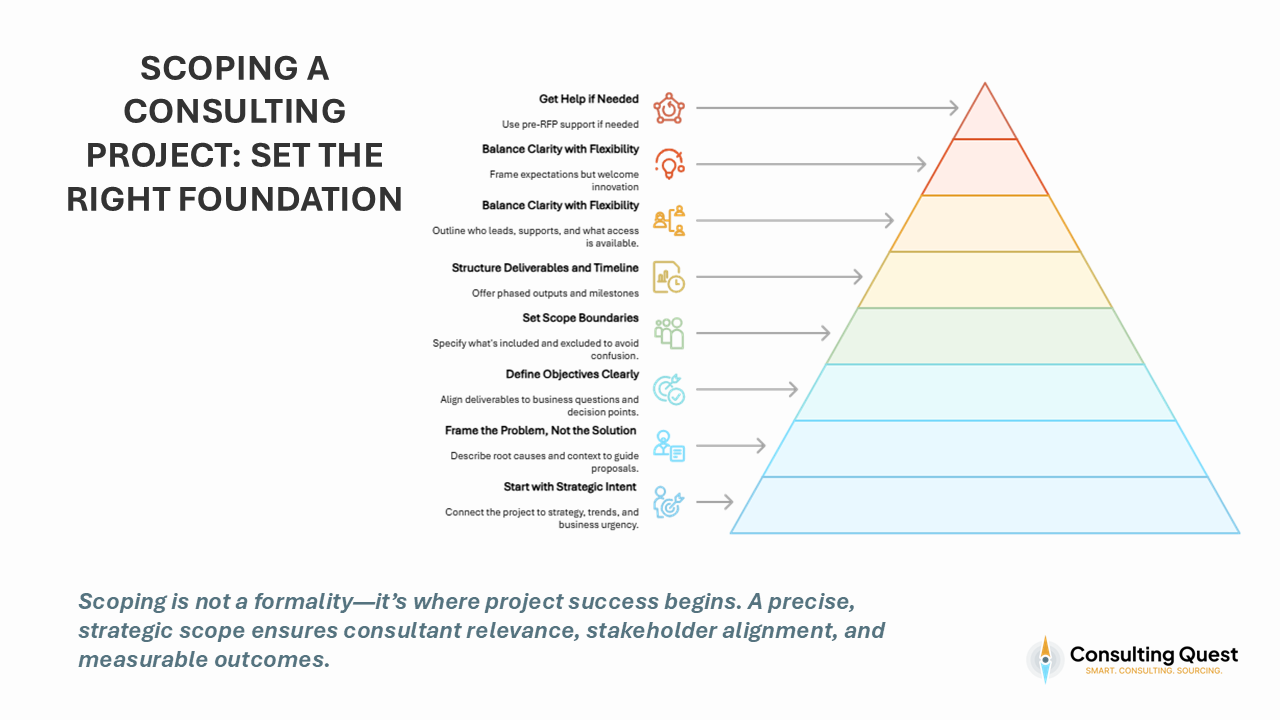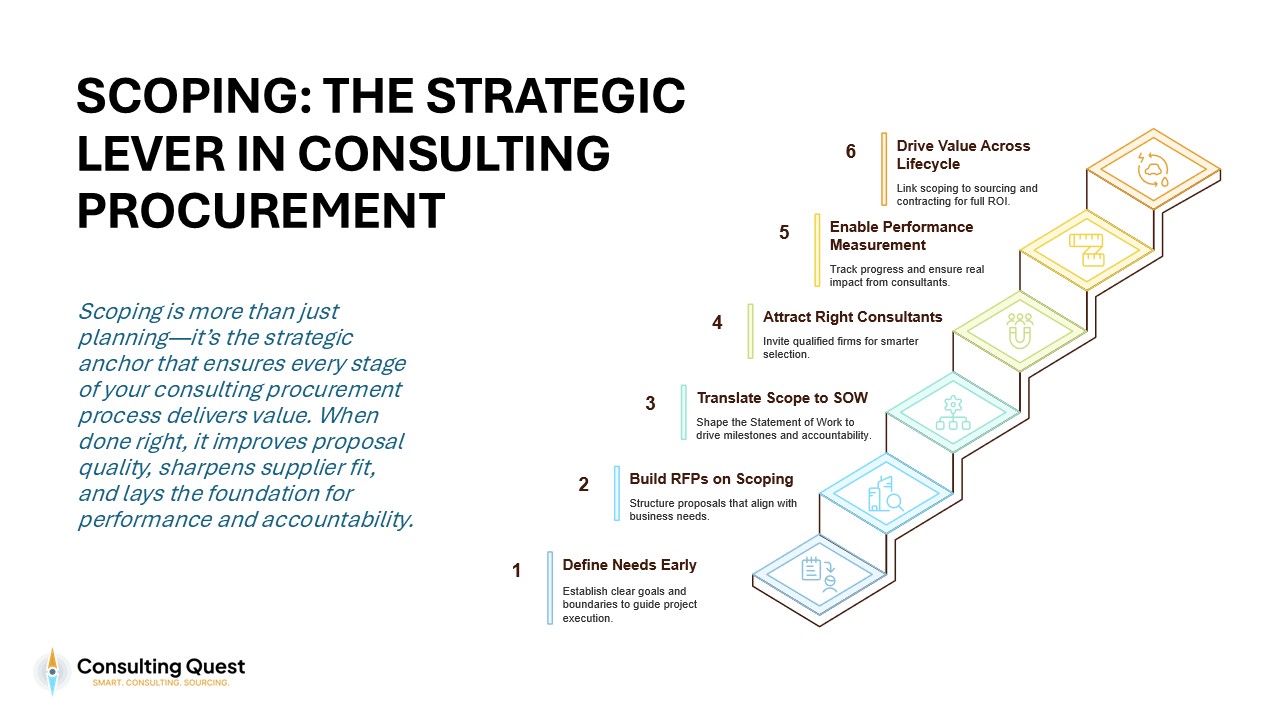Table of Contents
I. Why Scoping Is the Unsung Hero of Consulting Success
Imagine setting off on a road trip without knowing your destination—or worse, having five passengers each assuming you’re heading somewhere different. That’s what managing a consulting project feels like when the scope isn’t clearly defined. The result? Confused stakeholders, blown budgets, unmet expectations, and a consultant wondering what exactly they signed up for.
Scoping consulting projects is often overlooked, but it’s the bedrock of a successful engagement. It shapes everything—from how you write your RFP to how you negotiate deliverables and hold consultants accountable. And yet, it’s too often treated as an afterthought.
At Consulting Quest, we’ve seen it all: organizations diving into projects with barely a paragraph of “scope,” then scrambling later when things go sideways. But here’s the truth—getting your scope right is the single most powerful move you can make to ensure your project delivers results.
In this guide, we’ll walk you through a step-by-step framework to help you scope consulting projects like a pro. You’ll learn how to:
- Frame your scope clearly during the RFP development phase
- Refine and negotiate scope effectively during contract discussions
- Avoid the classic pitfalls that derail even the best intentions
Whether you’re in procurement, strategy, operations, or simply tasked with buying consulting services, this guide is for you. We’ll break it down with simple language, practical advice, and a dash of humor—because scoping doesn’t have to be boring to be brilliant.
Ready to set your project up for success? Let’s dive in.
II. Stage 1 – Scoping During the RFP Development Phase
Scoping a consulting project isn’t just a procurement exercise—it’s a strategic act. It defines how aligned your organization is, how well the consultants can respond, and ultimately, how successful the engagement will be. The RFP development phase is your one chance to anchor the project in clarity, context, and relevance.
Here’s how smart buyers build that scope—with precision, pragmatism, and purpose.

A. Start with the Strategic Intent
Consulting projects are typically triggered by a pressing challenge or opportunity. But it’s not enough to say, “We need help with our digital strategy.” You need to articulate why this project matters right now.
That means embedding the initiative in your strategic background:
- What industry trends are reshaping your business?
- What internal shifts (new leadership, M&A, market expansion) are driving this need?
- What previous actions or decisions led to this point?
This context matters—not just to inform the consultants, but to align internal stakeholders on why this project exists. It avoids the all-too-common scenario where half the organization is unclear on what the project is meant to achieve.
🛠 Reference: Your RFP Template includes a full section titled “Strategic Background” and “Rationale for the Project” to guide this framing effectively.
B. Define the Problem, Frame the Opportunity
Scoping starts with problem framing, not solutioning. Here, procurement leaders play a key role: pushing stakeholders to distinguish between symptoms and root causes.
For example:
- Don’t just say: “We need to reduce costs.”
- Say: “We are experiencing margin pressure in our EMEA operations due to legacy supply chain contracts. We suspect opportunities exist in vendor consolidation and process optimization, but lack internal bandwidth to assess and execute.”
You want to give consultants enough meat to challenge, structure, and refine—while being careful not to over-prescribe the solution.
🧩 Tip: Frame your scope with both quantitative signals (KPIs, benchmarks) and qualitative context (stakeholder friction, transformation goals).
C. Clarify Objectives, Not Just Tasks
A solid scope spells out what success looks like. That means clearly defined, prioritized objectives—framed at both the business and project level.
Consultants need to understand:
- What questions you expect them to answer
- What outcomes you want to enable
- What decision(s) their work should inform
For instance, your RFP might state:
“With the launch of the ‘Eastern Market Entry’ initiative, our aim is to:
- Validate market potential in three priority countries
- Assess competitive intensity and regulatory barriers
- Build a robust business case to present to the Board in Q3 2025
Note that this doesn’t just list tasks—it defines decision points and deliverables that tie into your internal roadmap.
D. Define the Scope—and What’s Out of Scope
Many project failures trace back to ambiguous or shifting boundaries. You must outline exactly what is expected, including:
- Geographies to cover
- Functions or divisions involved
- Analyses required (e.g., competitor benchmarking, stakeholder interviews)
- Depth vs breadth (a rapid diagnostic vs. a detailed roadmap)
Just as important: state what is not in scope. This helps manage internal expectations and avoids scope creep later in the project.
🔍 Example:
“The scope excludes implementation of recommended strategies. However, [Company] is open to exploring implementation support as a potential Phase 2.”
E. List Deliverables, Timelines, and Milestones
The best scopes provide a skeleton for the project timeline. Not a Gantt chart—but enough structure to align expectations and guide proposals.
Structure deliverables by project phase, and assign indicative milestones:
- Market analysis completed by end of Month 1
- Interim recommendations shared for feedback by Month 2
- Final presentation and business case ready by Month 3
Leave room for suppliers to propose alternative sequencing—but provide a logical base structure.
📁 Want a prebuilt framework? Download our Consulting RFP Template and use the “Expected Deliverables” section to guide your scoping.
F. Identify Internal Roles and Support Needs
Consultants need to know:
- Who the internal sponsor is
- What team will engage day-to-day
- What information and access they’ll receive
- Where gaps exist (e.g., limited market data, no internal PM)
Being transparent here helps vendors staff their team appropriately and propose realistic workloads.
Consider this template excerpt:
“The project will be led by our Strategy Group, working in close collaboration with BU leads in Europe. Consultants should expect weekly touchpoints and access to our internal market data and competitor repository.”
G. Balance Clarity with Flexibility
Here’s the paradox: you need to be specific enough to enable targeted proposals—but open enough to invite innovation.
This is the art of an “open but guided” RFP:
- Provide framing questions rather than detailed solutions
- Allow consultants to challenge your assumptions
- Ask for alternative approaches—and justify why
💬 Example RFP prompt:
“You are welcome to propose an alternative phasing if you believe it will yield greater insights or efficiency. Please justify your rationale and expected impact.”
H. Know When to Get Help Before the RFP
If you’re struggling to scope effectively—don’t wing it. Many organizations benefit from pre-RFP support, such as:
- Scoping workshops with stakeholders
- Market scans to assess feasibility
- Internal alignment sessions to clarify goals
At Consulting Quest, we often help clients co-build the RFP as a standalone service—ensuring the subsequent proposals are relevant, comparable, and aligned with their true needs.
III. Stage 2 – Refining Scope During the Negotiation Phase
So you’ve issued your RFP, evaluated the proposals, and narrowed it down to your preferred consulting firm. Great. But hold off on the champagne—this is where the real work begins.
The negotiation phase is not just about haggling over price. It’s where you align expectations, optimize delivery, and scope the project to deliver maximum impact for the right cost. And that requires precision. Enter the scoping levers—your toolkit for shaping a project that’s effective, lean, and executable.
Let’s unpack these levers in action.
A. Optimize Approach & Staffing
Consultants love designing elegant solutions—but those solutions come with teams, time, and invoices. You need to challenge how the work is done, who does it, and when they’re involved.
- Right-Sizing the Team
Top-tier consultants bring credibility—but not every task requires a Partner’s rate. Balance seniority and expertise:
- Use Partners sparingly for framing and steering.
- Deploy Managers for coordination.
- Reserve Associates for data crunching and support.
👉 Optimize the team structure like you would an investment portfolio—diversified, weighted, and performance-driven.
- Phase the Project for Impact
Split the work into logical phases, with clear go/no-go gates. For example:
- Phase 1: Diagnostic and strategic options
- Phase 2: Roadmap development and alignment
- Phase 3 (optional): Implementation support
This allows you to:
- Delay budget commitments until strategy is validated
- Adjust team size and profiles per phase
- Ensure early exit if no clear path emerges
- Tailor Consultant Involvement
Think beyond “full-service.” Match intensity to need:
- Train your team, then run the project internally.
- Advise with regular check-ins.
- Co-create in hybrid teams.
- Execute only when external horsepower is vital.
This sliding scale lets you reserve high-cost resources for high-value moments.
2. Ramp Up / Ramp Down Intelligently
The first and last weeks of a project often involve onboarding, knowledge transfer, or winding down. Don’t pay full fare for idle hours:
- Stagger team onboarding
- Limit travel or engagement hours early on
- Reduce team size gradually as deliverables are finalized
🎯 Consultants should be deployed like assets, not passengers—always contributing to value.
B. Scope to the Strict Necessary
Overengineering kills value. You don’t need 100 slides when 10 insights will do. Use this phase to carve the project to its strategic core.
a. Eliminate Redundancy
In complex organizations, multiple teams often run overlapping initiatives. Before approving scope:
- Check for internal resources or past projects covering similar ground
- Reuse internal IP and data
- Challenge the need for “fresh” research
🧠 Don’t pay consultants to rediscover what your intranet already knows.
b. De-Scope Without Diminishing Impact
Start by separating “must-haves” from “nice-to-haves.” Then apply a cost-benefit lens:
- Which activities drive the decision at hand?
- What can be deferred, split off, or replaced with internal work?
Descope iteratively, with stakeholder input—this isn’t a cut, it’s a surgical refinement.
c. Design to Cost
When the proposal exceeds budget, reverse the logic:
- Fix the budget
- Prioritize key outcomes
- Co-develop a right-sized scope with the consultants
This collaborative constraint forces creativity—and often reveals the real priorities. At Consulting Quest, we’ve seen this unlock significant savings without diluting value.
✅ Case in Point: We helped a client cut a project cost by 38% using “Design to Cost”—preserving impact while aligning budget with reality .
C. Optimize Delivery Setup
Sometimes, it’s not what you do—but who does it and how.
a. Make or Buy?
Don’t outsource what you can do in-house—especially if:
- You have an internal consulting group
- The knowledge needs to be retained
- The content is politically or strategically sensitive
Use consultants for high-value activities where they bring IP, expertise, or acceleration. Everything else? Consider “make.”
b. Leverage Non-Traditional Models
Freelance consultants and expert marketplaces can:
- Lower costs
- Speed up deployment
- Bring niche expertise
They’re not right for every project (e.g., those requiring political capital or transformation orchestration), but as part of your delivery mix, they offer real leverage.
Just make sure your sourcing strategy allows for flexibility.
D. Uncover Additional Levers
Here are two powerful tactics advanced buyers often use:
a. Volume Pooling
Group similar projects across geographies or business units. Benefits:
- Better pricing (volume discounts)
- Stronger bargaining power
- Access to higher-quality consultant teams
This only works if you plan early—but it can dramatically improve outcomes and cost-efficiency.
b. Activities Unbundling
Don’t default to one-stop shops. Break the project into distinct components:
- Strategy formulation → top-tier firm
- Market research → specialized boutique
- Training materials → freelance content creator
You get better expertise, at lower costs—and you’re not paying a premium for tasks outside the firm’s core strengths.
E. Real-World Application: A High-Stakes Negotiation
A mid-size tech firm wanted a top-tier firm to explore new market adjacencies. The proposals were 50% over budget. The client had already chosen their partner—no competition, no “make” option, and no interest in platforms.
What worked?
- We started with de-scoping—but misaligned stakeholders made that difficult.
- So we pivoted to Design to Cost. Consultants helped frame a proposal that met budget without losing impact.
- Then, we optimized staffing and phasing, reducing the number of opportunities analyzed and reallocating senior profiles.
🎯 Result? 38% cost savings, full stakeholder satisfaction, and even the consulting firm appreciated the process. That’s the power of smart scoping.
Want to Scope Like a Pro?
Don’t start from scratch. Download our Consulting RFP Template—the very same structure we use to help global clients define, scope, and launch high-impact consulting projects.
✔ Frame your strategic context clearly
✔ Define objectives and deliverables with precision
✔ Avoid scope creep and align stakeholders from day one
🎁 Download the RFP Template Now
(No email required—just smarter sourcing)
IV. Common Mistakes to Avoid When Scoping Consulting Projects
Even with a structured process and a solid template, it’s surprisingly easy to get scoping wrong. And when you do, the consequences ripple across cost, timelines, stakeholder alignment—and worst of all, results.
Here are the most common pitfalls we see, and how to sidestep them with confidence.
A. Over-Scoping: Trying to Solve Everything at Once
We get it—consulting projects are often launched under pressure. Leadership wants quick wins. Multiple teams want their pet priorities included. But too often, the result is an overloaded project with bloated objectives and conflicting deliverables.
- What it looks like: A 12-week project that aims to reimagine the operating model, run a full competitive benchmark, and deliver an implementation plan… across 4 regions.
- Why it fails: Consultants either dilute their focus or inflate timelines and fees. Internal teams can’t absorb the change. The value gets lost in the sprawl.
✅ Fix it: Use prioritization frameworks (e.g., MoSCoW, Eisenhower Matrix) and apply the 80/20 rule. Focus on the decisions that truly need to be enabled.
B. Under-Scoping: Not Providing Enough Detail
Vague scoping is a red flag—for consultants and internal stakeholders alike. It results in:
- Misaligned proposals
- Conflicting interpretations
- Endless back-and-forth during negotiation
This often stems from a reluctance to “get too detailed too early.” But clarity is not micromanagement—it’s risk management.
✅ Fix it: Be precise in your expectations. Use templates, examples, and prior project references. Include what’s in and out of scope, expected deliverables, and internal constraints.
📝 Reminder: Our Consulting RFP Template includes all these scoping prompts—download it now to avoid this trap.
C. Skipping Internal Alignment
Some of the worst scoping failures we’ve seen weren’t caused by bad consultants—but by misaligned sponsors.
- The CPO wants efficiency.
- The CFO wants savings.
- The BU head wants innovation.
- The project manager wants someone to just “do the work.”
If these priorities aren’t reconciled before scoping, the consultant gets a moving target. And everyone ends up disappointed.
✅ Fix it: Hold a stakeholder alignment session before finalizing the scope. Document shared goals and non-negotiables. If needed, use a neutral facilitator.
D. Treating the Scope as a Static Document
Think of your scope as a living contract—not just a line in the RFP. Once the project kicks off, realities shift:
- Assumptions prove wrong
- Data access gets delayed
- Priorities evolve
Yet too many clients refuse to revisit scope midstream—either out of fear or inertia. This leads to scope creep, missed milestones, or adversarial dynamics.
✅ Fix it: Build in review checkpoints and change control mechanisms. Make scope refinement a normal (and collaborative) part of execution.
E. Ignoring the Consultant’s Perspective
Consultants aren’t just vendors—they’re strategic partners. If your scope is one-sided, overly prescriptive, or based on rigid internal assumptions, you risk blocking the very value you’re hiring them for. And when that happens, you don’t just miss out on innovation—you undermine the entire engagement.
✅ Fix it: Invite consultants to critically engage with your scope during the proposal phase. Ask questions like:
“What would you challenge or adjust in our framing, based on your experience?”
Better yet, signal this explicitly in your RFP:
“We are open to alternative approaches or deliverables that you believe may better address our objectives, based on your experience in similar contexts.”
Smart consultants will take this cue and bring sharper thinking, better design, and often—more cost-effective solutions. You’re not losing control; you’re gaining leverage.
Here’s the final main section, connecting everything back to the broader consulting procurement ecosystem and reinforcing Consulting Quest’s leadership in the space.
V. Linking to Broader Procurement Excellence
Scoping, when done right, is more than just a planning exercise—it’s a cornerstone of strategic procurement. It shapes the quality of proposals, sets the tone for collaboration, and determines whether your project hits the mark or misses the moment.
But it doesn’t stand alone. To truly drive consulting performance, you need to integrate scoping into a broader framework of consulting procurement excellence.

Let’s connect the dots.
A. Scoping + RFP = Strategic Clarity
The RFP is your most powerful alignment tool—but only if it’s built on a solid scoping foundation. The two work hand-in-hand:
- Scoping defines the need, outcomes, and boundaries
- The RFP translates those into structured, comparable, and competitive proposals
That’s why our Consulting RFP Template is designed around a scoping-first philosophy. It starts with context, frames the challenge, and then leads into deliverables, support, and supplier expectations—so you get better proposals and better project outcomes.
📚 Want to go deeper? Check out our article on “Consulting RFP Made Easy” for a full breakdown of how to build RFPs that attract the right consultants
B. Scoping + SOW = Delivery Discipline
Once the project is awarded, the Statement of Work (SOW) becomes your delivery contract. A good SOW flows directly from a well-negotiated scope:
- Clear deliverables
- Defined milestones
- Agreed responsibilities
- Change control clauses
When scope is vague or fragmented, the SOW becomes a battlefield. When it’s tight and co-created, it’s a roadmap.
💼 See also: “MSA, SOW & Consulting Agreements—The Definitive Guide” for how to translate scope into enforceable agreements.
C. Scoping + Supplier Selection = Better Fit
A well-scoped project attracts the right type of consultants:
- Clear scope = better proposals = easier evaluation
- Specific needs = niche or boutique firms might shine
- Strategic framing = top-tier firms engage at a deeper level
In short, scope affects who applies, how they respond, and who you choose. That’s why selection criteria should include alignment with the scoped need—not just credentials or past performance.
🔍 If consultant fit is a priority, read: “How to Select the Right Consulting Firm”
D. Scoping + Performance Management = Real Impact
Consulting projects often fail in execution—not because the consultant didn’t try, but because the scope never clearly defined what success looked like.
When you scope for outcomes, not just outputs, you can:
- Track delivery progress against milestones
- Align internal teams to measure impact
- Hold consultants accountable for value—not just activity
🔎 Curious about tracking value delivery? Don’t miss our piece on “How Project Management Can Save You Millions”
Scoping isn’t just the start of the project—it’s the strategic inflection point where you define what success looks like, who will deliver it, and how you’ll measure it.
When you link scoping to the broader procurement lifecycle, it becomes a true driver of value—not just a step in the process.
VI. Scope to Win—Not Just to Start
In consulting, scope is destiny. It shapes what gets done, who does it, how much it costs, and whether it actually delivers impact. And yet, it’s still too often rushed, vague, or treated as a bureaucratic step.
But when you treat scoping as a strategic act—one that happens twice, once in the RFP and again in the negotiation—you unlock the full potential of your consulting investment.
You create:
- Better alignment internally
- Smarter, more targeted proposals
- Stronger relationships with your consultants
- And most importantly, real business outcomes
The tools are here. The templates exist. The levers are proven. Now it’s about building the discipline—and the mindset—to use them.
🎯 Whether you’re a seasoned procurement leader or just stepping into the world of consulting sourcing, remember: every successful project starts with a scope that’s sharp, shared, and strategic.
Ready to Get It Right From Day One?
Book a free consultation call with Consulting Quest to transform how you scope and buy consulting. We’ll help you:
- Align your stakeholders
- Structure your RFP
- Optimize your negotiation levers
So you can source smarter—and deliver bigger.







